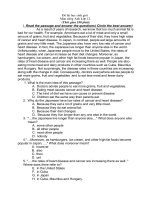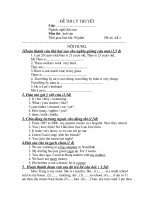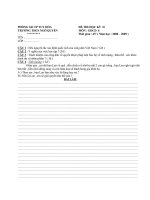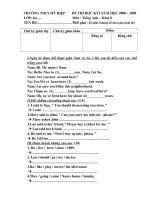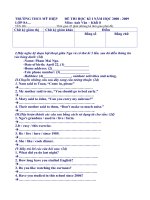ĐỀ THI ANH VĂN NGÀNH THÔNG DỊCH VIÊN ANH-PHÁP 2009 – 2010_1 potx
Bạn đang xem bản rút gọn của tài liệu. Xem và tải ngay bản đầy đủ của tài liệu tại đây (75.24 KB, 13 trang )
TRƯỜNG CD VĂN HÓA NGHỆ THUẬT VÀ DU LỊCH SÀI GÒN
ĐỀ THI ANH VĂN NGÀNH THÔNG DỊCH VIÊN ANH-PHÁP 2009 – 2010
THỜI GIAN: 90 PHÚT
I/ True (T) or False (F)
1. The U.S national government has no responsibilities to its education?
2. Education of all ages in the U.S is under the direct control of state and
local government.
3. Fund for running schools is provided by the U.S federal government and
taxes.
4. The national Board of Education decides the curriculum and general
standard of education.
5. In the U.S, education from school to university is free of charge.
6. Only students from elite private schools have chances to go to the best
American
Universities.
7. The majority of students at Harvard University are from elite private school
8. It is more difficult to get a chance to study at Harvard now than it was
before the
World War II.
9. All of the states in the U.S have their own universities.
II/ Answer the questions
1. What is K – 12?
2. What do American children learn at elementary schools?
3. What are “electives”? At what level of education are American children
offered electives?
4. What is “school board”? What does it do?
5. What kind of school conflicts with the ideal of equality of opportunity?
Why? Why do parents want their children to go to this kind of school?
6. Who is John Dewey? What are his two important ideas that influence the
American teaching
model?
7. What are the four principles of the American teaching model? Give
examples for each.
8. What is Special Education?
9. What are the two tracks of study provided by most high schools?
10. What are the different types of colleges in the United States?
11. What does a student take into consideration when choosing a college?
12. How to get accepted into a college?
13. What are the two things which prevent many American students from
attending university?
14. What kinds of courses does an American college student take?
15. Why do you think American universities are sometimes criticized for
offering too many electives? What is the advantage of doing so?
16. Where do American universities get money to run their institutions?
III/ Below is the American education ladder. Fill in the missing information.
Education
ladder
A
g
e
required
Grades
1.
(1)
5
2.
(2)
6
-
11
1
s
t
–
6
t
h
3.
S
econd
a
ry
schools
+ Junior high school/middle schools
+ High schools
12- 13/14
14/15
-
18
7
th
– 8
th
/9
th
t
h
t
h
4.
Hi
g
her
education
De
g
rees
4
.
1
Under
g
r
a
duate
studies
Bachelor
de
g
r
e
e/coll
e
g
e
4
.
2
Professional
studies
4
.
3
(4)
Master’s
d
e
g
ree
or
Doctoral
de
g
ree
* Religious instruction is offered by American religious private school but not
by
* An American student usually spends _ years at college to have a bachelor
degree.
* A large American University typically consists of several colleges, program,
one or more schools.
IV/ Choose the correct answer.
1. Which of these statements is not true?
a. American high school students have the choice of going to a free public
school or a private one where they must pay tuition.
b. The American education system is based on strong principles of equality of
opportunity.
c. After 12 years of schools American students receive a bachelor’s degree
diploma at graduation.
2. Which of these statements is
true?
a. Most of the money to pay for American public schools comes from
local taxes.
b. Religious schools that serve middle-class students receive money
from the national government, but elite private schools do not.
c. The national Department of Education determines the curriculum for all
schools and sets the standard for high school graduation and college
admission.
3. Since 1900, the percentage of young Americans who attend college has . .
. . . .
. a. Increased slightly from less than 10 percent to about 20
percent. b. Increased enormously from 10 percent to over 60
percent.
c. Stayed about the same, at around 20 percent.
4. What most Americans like most about higher education is . . . .
. . . . a. Its cultural value.
b. Its monetary
value. c. Its moral
value.
5. Which of the following would not be considered an extracurricular?
a. A school baseball team.
b. The student government of a
school. c. A classroom research
project.
Discussion
Imagine you plan an ideal school. Describe it in detail. You may want to
include the following points: Who would the student be? What kind of building
would you use? Would the school have a special emphasis? (science, music,
sports). What would the teachers be like? (age, experience, roles) Who would
determine the curriculum? What about tests and homework? How would
disciplines be maintained? What would be the role of the parents? What special
activities would the students have? What would a typical day like? What do you
think others would say about this school?
I. Choose the correct answer
1. The main reason the early settlers came to the North American
continent and established colonies was because they wanted to be free
from .
A. the power of kings, priests, and noble
men. B. the influence of their families.
C. the problems of poverty and hunger.
2. There are no titles of nobility in the United States today because .
A. no one likes aristocrats.
B. the church does not allow it.
C. they are forbidden by the Constitution.
3. The price that Americans pay for their individual freedom is .
A. self -
reliance B.
competition C.
hard work
4. The Americans belief in self - reliance means that .
A. receiving money from charity, family, or the government is never
allowed. B.
if a person is very dependent on others, he or she will
be respected by
others.
C. people must take care of themselves and be independent or risk
losing their personal freedom.
5. The American belief in equality of opportunity means that .
A. all Americans are rich.
B. Americans believe that everyone should be
equal. C. everyone should have equal chance to
succeed.
6. In the United States, learning to compete successfully is .
A. a part of growing up.
B. not seen as healthy by most people.
C. not necessary because the Americans believe in equality.
7. Traditionally, immigrants have been able to raise their standard of
living by coming to the United States because .
A. Americans value money and nothing else.
B. there have been such abundant natural
resources. C. the rich have shared their wealth
with the poor.
8. Americans see their material possessions as .
A. having nothing to so with social
status. B. the natural reward or their
hard work. C. no indication of a
person’s abilities.
9. The belief in the value of hard work .
A. developed because it was necessary to work hard to convert
national resources into material goods.
B. developed because the immigrants who came here had a natural love
of hard
work.
C. has never been a part of American value system because people
have so much.
10. In reality, such American ideals as equality of opportunity and self– reliance
.
A. are not real because there is no equality in the United States.
B. are always put into practice in the United States and truly
describe
American life.
C. are only partly carried out in real life but are still important because
people believe in them.
II/ Cloze Summary Paragraph. This paragraph summarizes the chapter.
Fill in each blank with any word that makes sense.
The
earliest settlers came (1) North America because
they (2)
to be free from (3) placed on their lives
(4)
European
government, churches and (5)
societies. They created
a (6)
nation where
the emphasis (7)
on
the
freedom of
(8)
individual.
The
price
paid
(9)
individual freedom is
(10) ; Americans are expected to take (11) of themselves and
not (12) on others. A second (13) _ why immigrants have come to
the United States is the (14) of opportunity. Americans (15)
that everyone should have an (16)
chance to succeed, the (17) for this equality is (18) for everyone. The
third reason why immigrants (19)
come is to raise their (20) of living. Material (21)
has
become
the measure (22) success and social (23)
, their (24) is the price. Material possessions are seen as the
natural
(25)
for
hard work. Although these six (26)
values may not always
(27)
put
in practice in (28)
, they are ideals which (29) every aspect of American (30)
.
III/ Which American traditional value is each statement about?
1.
Life
is
a
race.
The
winner
takes
it
all.
2.
You
have
to
work
hard
to
succeed
in
life.
3.
Everyone
can
have
a
chance
to
better
their
condition.
4.
Everyone
should
stand
on
their
own
two
feet.
5.
Money
is
a
measure
of
success
and
social
status.
6.
Americans
want
and
require
the
right
to
control
their
own
life.
IV/ Gap-filling
1. America is said to be hard to make generalizations about because of its
great
and & its population .
2. The main reason for many early settlers coming to America : freedom
from controls by kings, priests, and .
3. A retired factory worker feels unwanted by society because he is no
longer
working. His situation can be best described as the negative effects of .
4. The “American dream” best reflects the American value of .
5.
The
value
of
them suffer from
stresses.
causes Americans to be energetic, but it also
makes
6. The most basic and respected traditional American value is .
7. On the frontier, the family background was of importance.
8. Americans see their as the measure of success and social status.
9. American pop-stars are considered to be
V/ Which value does each of the following American practices reflect?
1.
Children
are
expected
to
leave
home
at
18
or
21.
2.
Children
get
involved
in
sports
at
a
young
age.
3.
Doping
in
sports
is
a
serious
crime.
4. Business first, chatting later. _
5. Show more respect to the young and men than the old and women.
class.
6.
“No
trespassing”,
“Keep
out
“
can
be
seen
at
the
gate
of
houses.
7.
“Go
Dutch”
when
eating
out.
8.
You
have
to
earn
your
respect.
9. Americans don’t expect a strong sense of commitment in friendship.
10.
Everyone
has
a
voice.
11.
“Rags
to
riches”
stories.
12.
Cheating
at
exam
or
plagiarism
is
a
serious
crime.
13.
Children are sometimes allowed to call their parents and grandparents by
their first names.
14.
Keeping
up
with
the
Joneses.
15.
“Time
is
money.”
16.
A
suspicion
of
a
strong
government.
17.
Marriage
for
love
18.
Informal
Americans

